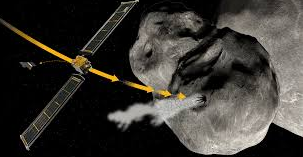Landmark mission demonstrates potential to redirect celestial threats and safeguard Earth from future disasters
In a groundbreaking planetary defense test, NASA successfully crashed a multimillion-dollar spacecraft into the asteroid Dimorphos, approximately 6.8 million miles from Earth. The mission, known as the Double Asteroid Redirection Test (DART), aimed to assess whether humanity could alter the trajectory of a celestial body on a potential collision course with Earth.
On Monday evening, at 7:14 PM EDT, the spacecraft struck the asteroid at an astounding speed of 15,000 mph. The collision, livestreamed by NASA, showcased the asteroid’s rocky surface moments before impact. Jubilation erupted in the mission control room as scientists from NASA and Johns Hopkins University celebrated the success of humanity’s first attempt to redirect an asteroid.
This achievement signifies a “new era for humankind,” as NASA explores innovative methods to protect the planet from catastrophic asteroid threats in the future.



Leave a Reply